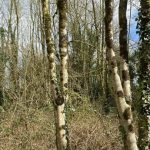
Due to the increasing campaign for the reduction of carbon emissions, the market for renewable biomass energy products has become a major part of the forestry industry in Ireland. One of these biomass energy products is wood chips from brash.
Historically residual brash comprising of branches and tree crowns also known as lop and top had no economic value and were left on site after timber harvesting. This lop and top was then gathered into long rows commonly known as windrows at reforestation stage. These windrows are somewhat unsightly and can also become a bit of a nuisance for future crop maintenance and harvesting operations. By removing a large percentage of this product from the forest floor, it makes it much easier to maintain the newly replanted crop as the ground is more accessible. Making site inspections and vegetation control both faster and safer due to the reduction of obstacles that can lead to slips, trips and falls. Another benefit being that the reduction in size or amount of windrows on site, makes it possible to achieve a higher restocking rate which will result in a better second rotation crop.
Due to the demand for wood chip as an energy source it can now be cost effective to recover brash from harvest sites. However to be cost effective a number of factors have to be taken into account some of which are:
- The proximity to the power station or processing yard as haulage costs are always on the rise.
- Is the access to the property sufficient, is it possible to access with walking floor trailers or are smaller vehicles such as tractor and trailer required.
- Does the property offer adequate stacking space or will the chipper need to make multiple visits to relieve the stacking area.
- How long is the extraction route as this will determine the cost of forwarding the material to roadside.
- Are the ground conditions/topography favourable – On difficult terrain extraction costs can be rather costly due to time and sometimes additional machinery required.
Aside from the factors above that are necessary to make the operation cost effective, there are also a number of crucial points that need to be assessed to ensure the property is suitable for brash recovery. Below I have outlined some of these considerations.
- Are there any environmental threats or concerns on site that brash recovery could have a negative impact on – These being threats to animal habitats such as breeding grounds, along with the potential for site run off which could result in water pollution.
- Would the removal of the organic matter deprive the soil of much needed nutrients for future crop rotations – In most cases it is best to wait for needle and leaf drop before the extraction of this product.
- Has there been any heavy rutting on site from previous timber harvesting operations or is there potential for significant compaction or ground damage to be caused by the extraction of the lop and top.
- Is there a time period in which activities should take place to minimise and ground disturbance.
- Does the ground contain a lot of rock out crop which could result in uncomfortable machinery operating conditions or damage to machinery especially wood chippers.
Another avenue for brash recovery stepping aside from the energy market, is the use of brash for composting material. This is more of a niche market where the lop and top is removed whilst fresh and cultivated for the use as a component or diluent in the production of composting materials as a substitute for peat. In this case the brash is generally processed with a shredder rather than a chipper. The purpose of this is to produce a finer grade material that is easier to breakdown during the composting process. At present this product is in a lower demand and offers a lower financial return.
For further details please contact us at
www.ForestryServices.ie www.Ashdieback.ie www.Euroforestireland.ie




